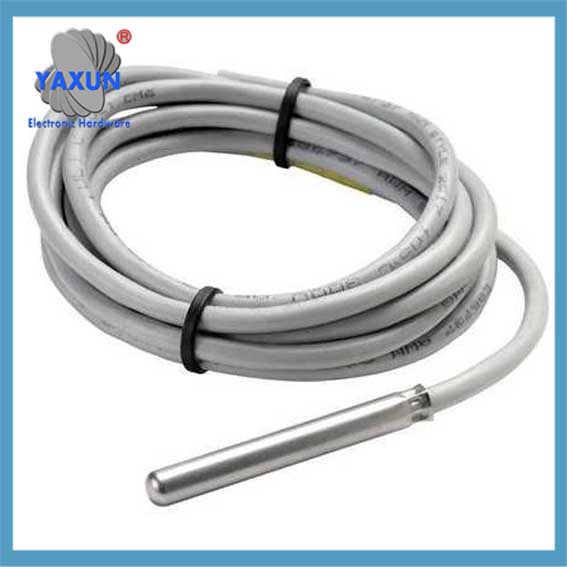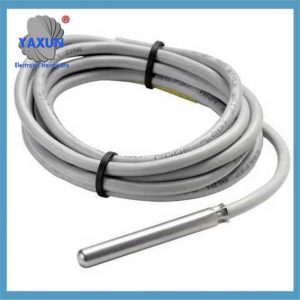產品類別
產品標籤
NTC, 正溫度係數, PT100, DS18B20 用於溫度探頭感測器
熱電偶探頭: 它利用熱電效應來測量溫度, 並具有測量範圍寬、反應速度快的特點.
熱電阻探頭: 利用金屬或半導體材料的電阻隨溫度變化的特性來測量溫度, 並具有測量精度高、穩定性好等特點.
半導體探針: 利用半導體材料的電導率隨溫度變化的特性來測量溫度, 並具有體積小等特點, 重量輕、耗電量低.
NTC, 正溫度係數, PT100, DS18B20溫度探針和溫度傳感器在溫度測量領域起重要作用. 以下是溫度探針傳感器的詳細介紹:
溫度感測器有很多種類型, 包括:
熱電偶
這些傳感器由兩種不同的金屬組成,它們在兩個點上連接以形成一個連接. 他們是可靠的, 準確的, 並且可以在廣泛的溫度下運行.
電阻溫度探測器 (RTD)
這些傳感器基於金屬的電阻變化,隨著溫度的變化.
熱敏電阻
這些傳感器使用半導體電阻的溫度特性, 隨著溫度的變化而改變電阻. 熱敏電阻很敏感,相對於成本具有很高的精度.
負溫度係數 (NTC) 熱敏電阻
這些傳感器很敏感,可以響應很小的溫度變化. 他們的溫度範圍為 -50 °C 至 250 ℃.
電阻溫度探測器
這些傳感器具有正溫係數 (正溫度係數) 並提供精確的溫度測量. 然而, 他們的敏感性很差.
1. 定義和工作原則
溫度探針:
定義: 溫度探針是一種專門用於測量溫度的設備, 它的核心成分是溫度敏感元素.
工作原理: 溫度探針使用敏感元素 (例如熱電偶, 熱電阻, 半導體, ETC。) 將溫度變化轉換為電信號,以進行隨後的電路處理或顯示.
溫度傳感器:
定義: 溫度傳感器是一個更廣泛的概念,其中包括溫度探針和連接的信號處理電路.
工作原理: 溫度傳感器不僅包括一個敏感元件, 但也有一個信號處理電路,可以完成收購, 溫度訊號的處理和輸出, 通常以數字或模擬信號的形式.
2. 類型和特徵
溫度探針類型:
熱電偶探頭: 它利用熱電效應來測量溫度, 並具有測量範圍寬、反應速度快的特點.
熱電阻探頭: 利用金屬或半導體材料的電阻隨溫度變化的特性來測量溫度, 並具有測量精度高、穩定性好等特點.
半導體探針: 利用半導體材料的電導率隨溫度變化的特性來測量溫度, 並具有體積小等特點, 重量輕、耗電量低.
溫度傳感器類型:
模擬溫度傳感器: 輸出模擬信號, 需要通過模數轉換器將其轉換為數字信號,以進行後續處理.
數字溫度傳感器: 直接輸出數字信號, 具有強大的抗干擾能力, 高精度, 並且易於集成到控制系統.
智能溫度傳感器: 有自我診斷, 自校準, 溝通和其他功能, 並可實現遠端監控與控制.
3. 選擇和應用
選擇因素:
應用環境: 考慮被測環境是否有腐蝕性等特殊條件, 高溫, 高壓, ETC。, 從而選擇合適的材質和防護等級.
測量範圍: 根據被測溫度範圍選擇合適的感測器,確保感測器在要求的範圍內準確測量.
準確性要求: 根據溫度測量應用的準確性要求, 選擇具有相應精度的傳感器.
成本預算: 在確保表現的前提下, 考慮成本因素並選擇具有成本效益的傳感器.
申請區:
工業自動化: 用於監測工業設備的溫度變化, 機器和生產過程以確保設備和產品質量的正常運行.
醫療行業: 用於醫療設備, 溫度監測儀器和藥物存儲設備以監測患者溫度, 環境溫度和藥物存儲條件.
汽車產業: 用於電動汽車電動機, 電容器, 直流轉換器, 充電系統, 以及汽車發動機, 變速箱, 空調系統和排氣系統,以監視和控制各種液體和氣體的溫度.
農業和食品加工業: 用於農業溫室, 冷藏, 食品加工設備和運輸車輛以監視和控制農產品和食物的溫度.
其他字段: 例如空調和製冷行業, 軍事和航空航天行業, 物聯網行業, ETC. 也廣泛使用.
四號. 使用與維護
安裝: 根據安裝說明正確安裝傳感器,以確保傳感器與要測量的對象之間的良好接觸並避免由不當安裝引起的測量錯誤.
接線: 正確連接感測器的訊號線和電源線,確保訊號傳輸的穩定性和準確性.
校準: 定期校準感測器,確保其測量精度符合應用要求. 校準過程通常涉及將傳感器放置在已知的溫度環境中, 比較其輸出值與標準值之間的差, 並進行必要的調整.
維護: 定期清潔和維護感測器,避免灰塵, 污垢, ETC. 影響傳感器的測量性能. 同時, 請注意檢查電纜連接是否鬆動還是損壞, 並及時更換損壞的零件.
總之, 溫度探針傳感器在溫度測量領域具有廣泛的應用和重要位置. 選擇和使用它們, 有必要根據特定的應用方案和要求進行全面的考慮,以確保測量結果的準確性和可靠性. 如果您還有其他問題或需要進一步的幫助, 請隨時讓我知道.
聯絡我們
等待您的電子郵件, 我們將在短時間內回覆您 12 小時提供您所需的有價值的信息.
 English
English Afrikaans
Afrikaans العربية
العربية বাংলা
বাংলা bosanski jezik
bosanski jezik Български
Български Català
Català 粤语
粤语 中文(简体)
中文(简体) 中文(漢字)
中文(漢字) Hrvatski
Hrvatski Čeština
Čeština Nederlands
Nederlands Eesti keel
Eesti keel Suomi
Suomi Français
Français Deutsch
Deutsch Ελληνικά
Ελληνικά हिन्दी; हिंदी
हिन्दी; हिंदी Magyar
Magyar Bahasa Indonesia
Bahasa Indonesia Italiano
Italiano 日本語
日本語 한국어
한국어 Latviešu valoda
Latviešu valoda Lietuvių kalba
Lietuvių kalba македонски јазик
македонски јазик Bahasa Melayu
Bahasa Melayu Norsk
Norsk پارسی
پارسی Polski
Polski Português
Português Română
Română Русский
Русский Cрпски језик
Cрпски језик Slovenčina
Slovenčina Slovenščina
Slovenščina Español
Español Svenska
Svenska ภาษาไทย
ภาษาไทย Türkçe
Türkçe Українська
Українська اردو
اردو Tiếng Việt
Tiếng Việt












